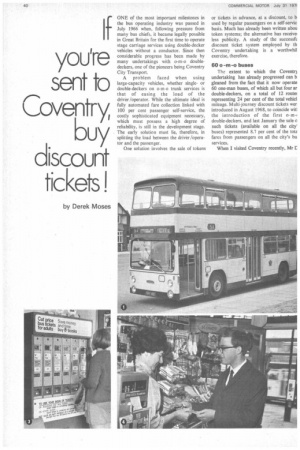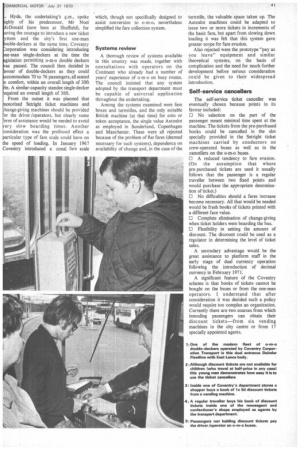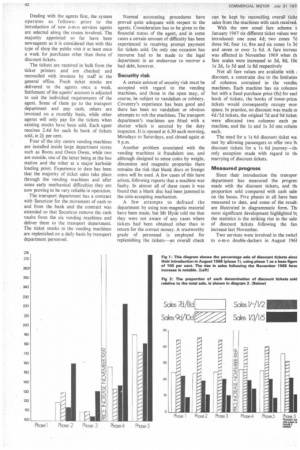you're sent to Coventry buy discount tickets!
Page 42

Page 43

Page 44

Page 45

If you've noticed an error in this article please click here to report it so we can fix it.
ONE of the most important milestones in the bus operating industry was passed in July 1966 when, following pressure from many bus chiefs, it became legally possible in Great Britain for the first time to operate stage carriage services using double-decker vehicles without a conductor. Since then considerable progress has been made by many undertakings with o-m-o doubledeckers, one of the pioneers being Coventry City Transport.
A problem faced when using large-capacity vehicles, whether singleor double-deckers on o-m-o trunk services is that of easing the load of the driver/operator. While the ultimate ideal is fully automated fare collection linked with 100 per cent passenger self-service, the costly sophisticated equipment necessary, which must possess a high degree of reliability, is still in the development stage. The early solution must lie, therefore, in splitting the load between the driver /operator and the passenger.
One solution involves the sale of tokens
or tickets in advance, at a discount, to b used by regular passengers on a self-servic basis. Much has already been written abou token systems; the alternative has receive' less publicity. A study of the successfu discount ticket system employed by th Coventry undertaking is a worthwhil exercise, therefore.
60 o-m-o buses
The extent to which the Coventry undertaking has already progressed can b gleaned from the fact that it now operate 60 one-man buses, of which all but four ar double-deckers, on a total of 12 route5 representing 24 per cent of the total vehici mileage. Multi-journey discount tickets wer introduced in August 1968, to coincide wit] the introduction of the first o-m-4 double-deckers, and last January the sale o such tickets (available on all the city' buses) represented 8.7 per cent of the tote fares from passengers on all the city's bu services.
When I visited Coventry recently, Mr E
Hyde, the undertaking's g.m., spoke 'ghly of his predecessor, Mr Noel cDonald (now boss at Sheffield), for aving the courage to introduce a new ticket ystem and the city's first one-man • ouble-deckers at the same time. Coventry orporation was considering introducing ne-man single-deckers at the time the gislation permitting o-m-o double deckers as passed. The council then decided in avour of double-deckers as they could ccommodate 70 to 76 passengers, all seated n comfort, within an overall length of 30ft in. A similar-capacity standee single-decker equired an overall length of 36ft.
From the outset it was planned that otorized Setright ticket machines and hange-giving machines should be provided or the driver /operators, but clearly some orm of assistance would be needed to avoid cry slow boarding times. Another onsideration was the profound effect a • articular type of fare scale could have on the speed of loading. In January 1967 Coventry introduced a zonal fare scale which, though not specifically designed to assist conversion to o-m-o, nevertheless simplified the fare collection system.
Systems review A thorough review of systems available in this country was made, together with consultations with operators on the Continent who already had a number of years' experience of o-m-o on busy routes. The council insisted that any system adopted by the transport department must be capable of universal application throughout the undertaking.
Among the systems examined were fare boxes and turnstiles, and the only suitable British machine (at that time) for coin or token acceptance, the single value Autoslot as employed in Sunderland, Copenhagen and Manchester. These were all rejected because of the problem of flat fares (deemed necessary for such systems), dependence on availability of change and, in the case of the turnstile, the valuable space taken up. The Autosiot machines could be adapted to issue two or more tickets in increments of the basic fare, but apart from slowing down loading it was felt that this system gave greater scope for fare evasion.
Also rejected were the prototype "pay as you leave" equipment and similar theoretical systems, on the basis of complication and the need for much further development before serious consideration could be given to their widespread introduction.
Self-service cancellers
The self-service ticket canceller was eventually chosen because points in its favour included:
D No selection on the part of the passenger meant minimal time spent at the machine. The tickets from the pre-purchased books could be cancelled in the slot specially provided in the Setright ticket machines carried by conductors on crew-operated buses as well as in the cancellers on the o-m-o buses.
• A reduced tendency to fare evasion.
(On the assumption that where pre-purchased tickets are used it usually follows that the passenger is a regular traveller between two fixed points and would purchase the appropriate denomination of ticket.) O No difficulties should a fares increase become necessary. All that would be needed would be fresh books of tickets printed with a different face value.
O Complete elimination of change-giving when ticket holders were boarding the bus. Cl Flexibility in setting the amount of discount. The discount could be used as a regulator in determining the level of ticket sales.
A secondary advantage would be the great assistance to platform staff in the early stage of dual currency operation following the introduction of decimal currency in February 1971: A significant feature of the Coventry scheme is that books of tickets cannot be bought on the buses or from the one-man operators. I understand that after consideration it was decided such a policy would require too complex an organization. Currently there are two sources from which intending passengers can obtain their discount tickets—from six vending machines in the city centre or from 17 specially appointed agents. Dealing with the agents first, the system operates as follows: prior to the introduction of new o-m-o services agents are selected along the routes involved. The majority appointed so far have been newsagents as it is considered that with this type of shop the public visit it at least once a week for purchases other than those of discount tickets.
The tickets are received in bulk from the ticket printers and are checked and reconciled with invoices by staff in the general office. Fresh ticket stocks are delivered to the agents once a week. Settlement of the agents' account is adjusted to suit the individual requirements of the agent. Some of them go to the transport department and pay cash, others are invoiced on a monthly basis, while other agents will only pay for the tickets when existing stocks have been sold. Each agent receives 2.4d for each 8s book of tickets sold, ie per cent.
Four of the city centre vending machines are installed inside large department stores such as Boots and Owen Owen, while two are outside, one of the latter being at the bus station and the other at a major kerbside loading point. Experience to date has been that the majority of ticket sales take place through the vending machines and after some early mechanical difficulties they are now proving to be very reliable in operation.
The transport department has a contract with Securicor for the movement of cash to and from the bank and the contract was extended so that Securicor remove the cash vaults from the six vending machines and deliver them to the transport department. The ticket stocks in the vending machines are replenished on a daily basis by transport department personnel. Normal accounting procedures have proved quite adequate with respect to the agents. Consideration has to be given to the financial status of the agent, and in some cases a certain amount of difficulty has been experienced in receiving prompt payment for tickets sold. On only one occasion has recourse had to be made to the legal department in an endeavour to recover a bad debt, however.
Security risk A certain amount of security risk must be accepted with regard to the vending machines, and those in the open may, of course, be subject to vandalism or robbery. Coventry's experience has been good and there has been no vandalism or obvious attempts to rob the machines. The transport department's machines are fitted with a shutter which is secured by the duty inspector. It is opened at 6.30 each morning, Mondays to Saturdays, and closed again at 9 p.m.
Another problem associated with the vending machines is fraudulent use, and although designed to sense coins by weight, dimension and magnetic properties there remains the risk that blank discs or foreign coins will be used. A few cases of this have arisen, following reports that a machine was faulty. In almost all of these cases it was found that a blank disc had been jammed in the coin-accepting mechanism.
A few attempts to defraud the department by using non-magnetic material have been made, but Mr Hyde told me that they were not aware of any cases where tickets had been obtained other than in return for the correct money. A trustworthy grade of personnel is employed for replenishing the tickets—an overall check can be kept by reconciling overall ticke sales from the machines with cash received.
With the new zonal fare scheme ii January 1967 six different ticket values wer introduced: one zone 4d; two zones 7d three 9d; four is; five and six zones Is 3d and seven or over is 6d. A fare increas was effected in November 1969 when th fare scales were increased to 5d, 8d, 10e is 2d, Is 5d and is 8d respectively Not all fare values are available with discount, a constraint due to the limitatiot of columns contained in the vendim machines. Each machine has six columns but with a fixed purchase price (8s) for eael book of tickets, the books of lower-pricet tickets would consequently occupy moo space. In practice, no discount was made ca 4d/5d tickets, the original 7d and 9d ticket were allocated two columns each pe machine, and the is and Is 3d one columi each.
The need for a Is 6d discount ticket wa met by allowing passengers to offer two 9( discount tickets for a Is 6d journey—thi only exception made with regard to thi marrying of discount tickets.
Measured progress Since their introduction the transpor department has measured the progres: made with the discount tickets, and th4 proportion sold compared with cash sale on the buses. Five phases in all have beet measured to date, and some of the result: are illustrated in diagrammatic form. Thi most significant development highlighted 13), the statistics is the striking rise in the sale: of discount tickets following the fan increase last November.
Two services were involved in the switcl to o-m-o double-deckers in August 196f
• , •
phase one) when discount tickets were first ntroduced. The services in question epresented 7 per cent of the total mileage perated. The statistics for this phase were aken over a period of two months to allow he new system and new type of bus peration time to settle down.
Phase two represents the switch in March 969 of four more routes to one-man ouble-deckers, when the total route mileage operated rose to 171 per cent. The gures used for comparison were taken one onth after the change-over. The figures for he third phase were taken in October 1969, even months after phase two and 13 onths after the system was introduced.
Two months later the figures for phase four were taken, to judge the effect of the fares increase of the previous month. Finally, in January 1970, two more routes were converted, the mileage thus operated increasing to 24 per cent of the undertaking's total mileage. The phase five figures were measured one month later.
pclespread publicity Diagram I illustrates the effect of xtending one-man-operation and the fares ncrease on the sale of discount tickets. The introduction of the new system was naturally accompanied by an intensive publicity campaign. No fewer than 10,000 leaflets explaining the system were issued and half-page coloured advertisements were published in the local evening paper.
Phase two was also accompanied by a certain amount of publicity, though not to the extent as with stage one of the conversion. Nevertheless, the introduction of more o-m-o buses increased the sale of discount tickets, as one would expect. The striking increase in the sale of Is 3d value tickets over other denominations reflects the fact that the routes converted at this stage were longer than those of phase one.
The considerable slump in discount sales shown in phase three, where the percentage of tickets sold was almost back to the original level, is partly explained by a deliberate policy of allowing the publicity campaign to lapse after phase two. This factor makes the results of phase four all the more outstanding, where the usage of discount tickets shot up following the fares increase, despite the continued absence of publicity.
Another remarkable feature of the fares rise was the absence, for the first time in many years, of an increase in passenger recession. This resulted in a much higher revenue than anticipated. A substantial increase in the level of discount available on pre-purchased tickets after the fares increase also helped to boost discount sales. The most outstanding example was the Is 3d/1s 5d ticket, where the discount was raised from 8.57 per cent to 19.33 per cent, followed by an increase in sales of almost 100 per cent.
One of the biggest drawbacks at present is the availability of discount tickets on crew-operated buses—not exactly a viable exercise. However, this paradox will be gradually resolved as the conversion, which will eventually embrace all services, continues. Due this year for o-m-o are 36 Daimler Fleetline 9m double-deckers, with the body order split between Park Royal and East Lancs.
Looking even further ahead, 56 Daimler Fleetlines are on order for delivery in 1971/2, of which 28 will have East Lanes bodies. Consideration is being given as to whether one or two doorways should be fitted to the latter, but that is another story.
































































































